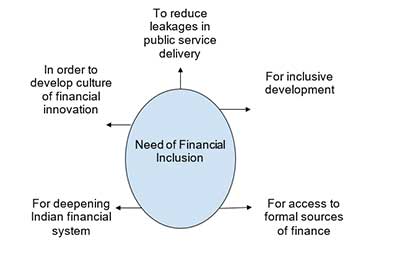Relevance: GS-2 : Issues Relating to Development and Management of Social Sector/Services relating to Health, Education, Human Resources, Welfare Schemes for Vulnerable Sections of the population by the Centre and States and the Performance of these Schemes; Mechanisms, Laws, Institutions and Bodies constituted for the Protection and Betterment of these Vulnerable Section
Relevance: GS-3 : Inclusive Growth and issues arising from it, Science and Technology- Developments and their Applications and Effects in Everyday Life
Key Phrases: Financial Inclusion, Inclusive Growth; Sabka Saath, Sabka Vikas, Sabka Vishwas; National Asset Reconstruction Company (NARCL)
Why in news?
- Budget 2022-23 has included ‘Inclusive Development’ as one of the 4 key areas to be targeted to achieve Amrit Kaal
- Financial inclusion is a key facet of Inclusive Development
What is financial inclusion?
- As per World Bank (WB), Financial inclusion means that individuals and businesses have access to useful and affordable financial products and services that meet their needs – transactions, payments, savings, credit and insurance – delivered in a responsible and sustainable way
- Affordability, Accessibility and Availability of Financial products and services forms the 3-pillars of Financial Inclusion
- To have transaction account is the initial step to financial inclusion
Key Highlights of the article
- Success of countries is defined by the relative prosperity of its
people
- government is focused on ensuring the availability of basic services in its remotest regions to ensure no person is left behind in the development journey
- essence of this principle was aptly captured in Prime Minister Narendra Modi’s clarion call of “Sabka Saath, Sabka Vikas, Sabka Vishwas”
- PM has also set out a vision for ‘India at 100’,
- This includes complementing macro-economic growth with a micro-economic level inclusive-welfare focus.
- A major part of this inclusive-welfare vision is to improve financial inclusion in India significantly
- He has highlighted the strength of the Indian financial system,
backed by a robust set of government interventions by way of reforms and
schemes
- This has encouraged bankers to invest in innovations to achieve greater financial inclusion
- RBI has constituted an innovation hub to address the challenges of
financial inclusion and efficient banking.
- Which has led to recovering ₹5 Tn from financial defaulters
- National Asset Reconstruction Company (NARCL) has been created as an
initiative of resolving stressed assets worth ₹2 trillion
- In 2021, an asset-quality review had reported that the gross non-performing assets (NPAs) of public sector banks had decreased by 31.2%
- 100% of India’s 150,000 post offices will be brought into the core
banking system
- It will allow access to accounts through net banking, mobile phones and ATMs, and allow the online transfer of funds between post office accounts and bank accounts
- This decision will be especially beneficial to farmers and senior citizens in rural areas
- Digitization of financial services has been a catalyst in spreading
the benefits of development to all in society
- A case in point is the JAM trinity of Jan Dhan-Aadhaar-Mobile. Interlinking of bank accounts, Aadhaar and mobile numbers with an individual’s identity was first done under a pilot project to understand the reasons for leakages in subsidy disbursement
- Subsidies provided by the government are provided through a direct benefit transfer (DBT) mechanism to beneficiaries without the involvement of middlemen or agencies where many leakages were identified
- In 2020-21, ₹2.1 trillion was sent directly to people’s accounts under schemes such as the Mahatma Gandhi National Rural Employment Guarantee Act, public distribution system and Pradhan Mantri Awas Yojana, among others
- Jan Dhan Yojana has also proved to be a game-changer during the unprecedented covid-related lockdown in 2020. Effective subsidy transfers helped ensure that incentives reached their rightful beneficiaries despite the extraordinary circumstances that existed at the time.
- The ministry of finance has encouraged the empowerment of urban and
rural cooperative banks
- Will lead to realisation of vision of a financially-inclusive India
- India has witnessed a 72% rise in the number of digital payments processed in 2021
- Best Examples
- Bank mobile vans in Aurangabad.
- These mobile vans provide banking and ATM services with the aim of spreading financial awareness and enabling people
- National Bank for Agriculture and Rural Development to launch 12 additional mobile vans
- Bank mobile vans in Aurangabad.
- For increasing financial literacy, meetings were held with the state-level committee of bankers to push credit outreach programmes
- The ministry has also backed a decision to open 57 new bank branches in Assam and 30 branches in Manipur to speed up development in the country’s northeast region.
Steps taken to achieve Financial Inclusion
- Government
- PM Mudra Yojana - for small loans to non-corporate businesses
- PM Jan Dhan Yojana
- Insurance scheme - PM Suraksha Bima Yojana and Jeevan Jyoti Beema Yojana
- Pension Scheme - Atal Pension Yojana, Pradhan Mantri Kisan Maan Dhan Yojana, Pradhan Mantri Shram Yogi Mann Dhan Yojana (PM-SYM)
- Nandan Nilekani Panel on deepening of Digital Payments
- Kisan Credit Card
- RBI
- National Strategy for Financial Inclusion (NSFI) 2019-24
- Payment Infrastructure Development Fund (PIDF)
- ATM infrastructure
- Project Financial Literacy
Conclusion
- The Indian government aims to empower its citizens through financial inclusion to achieve greater economic heights. The aim would be to further bolster development for each and every citizen with financial literacy while enhancing the prosperity of people through digitization.
Source: MINT
Mains Question:
Q. Why is Financial Inclusion necessary for India? Mention the steps taken by different stakeholders in achieving this goal. (10 Marks)









